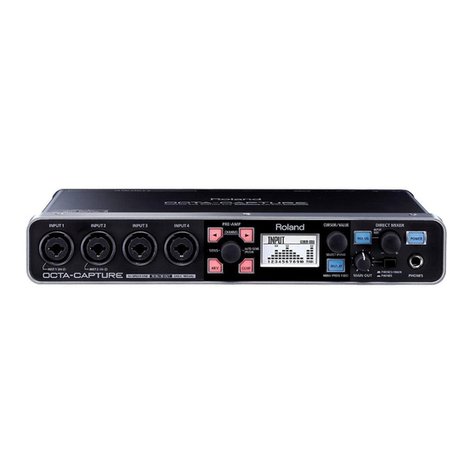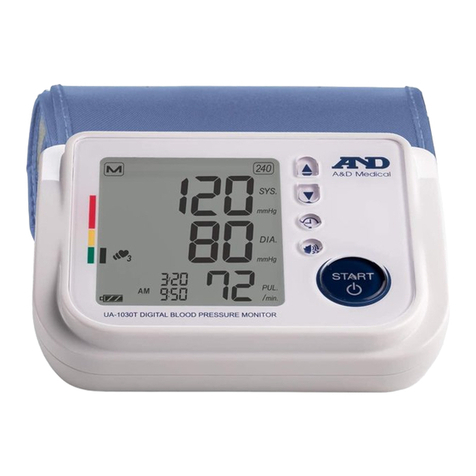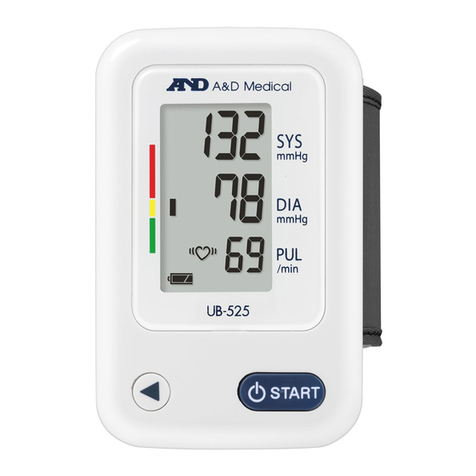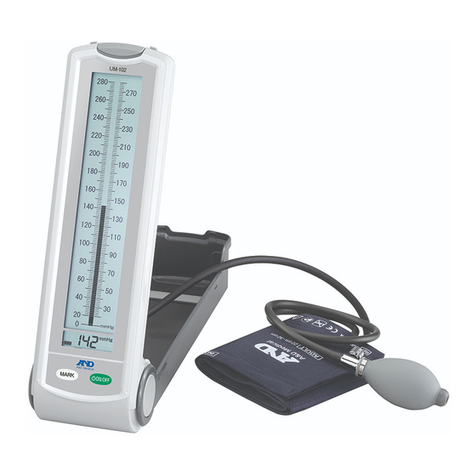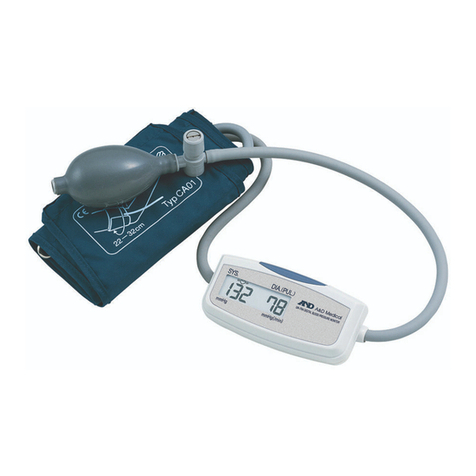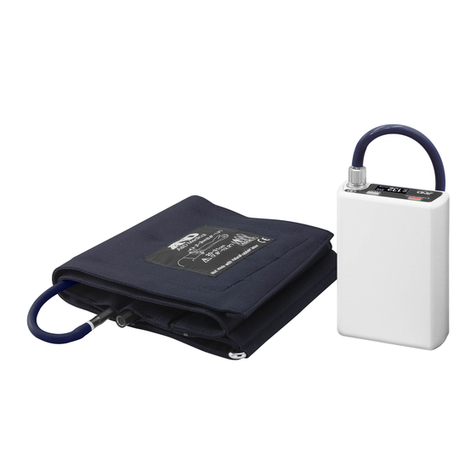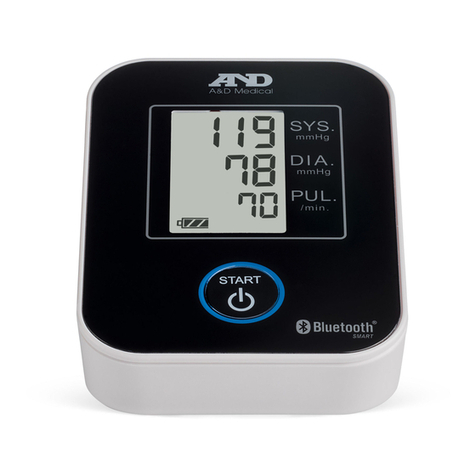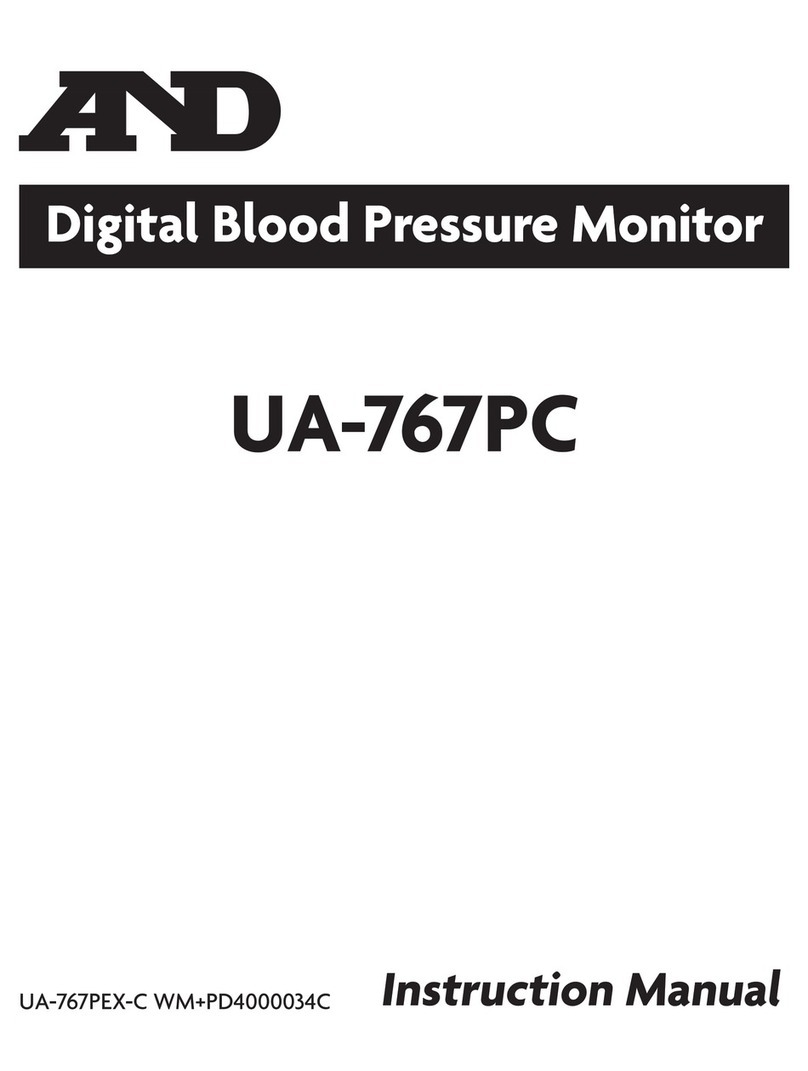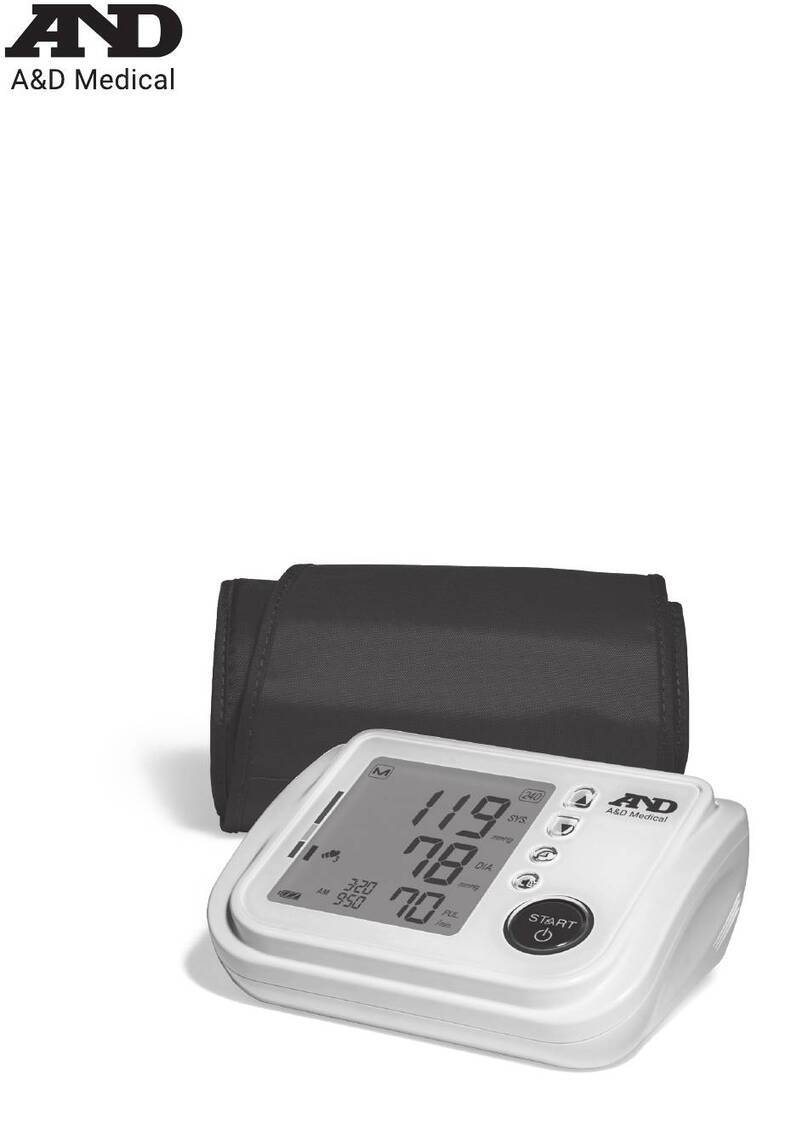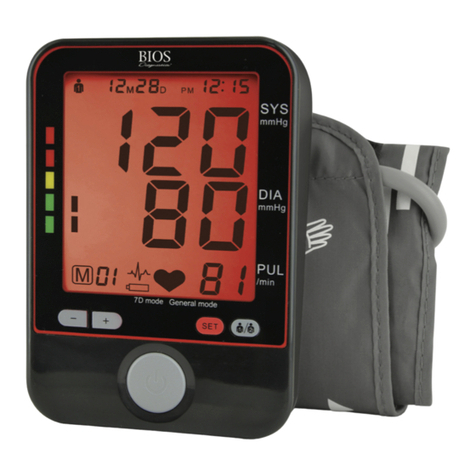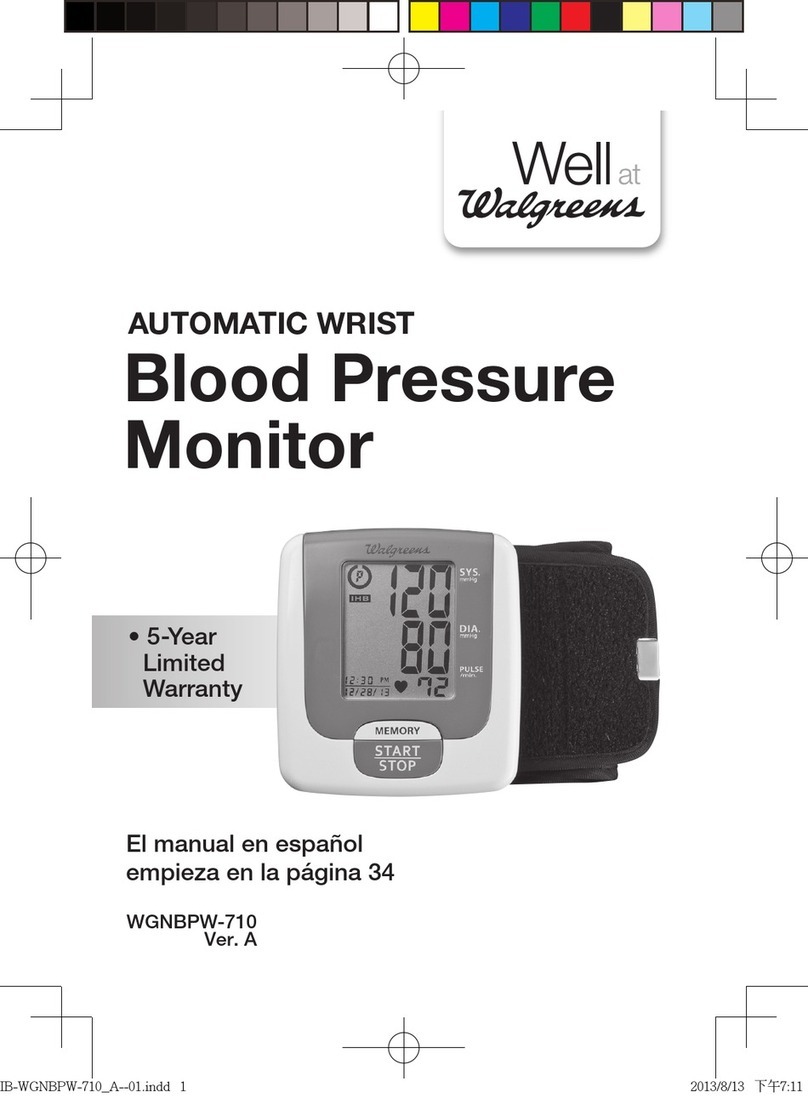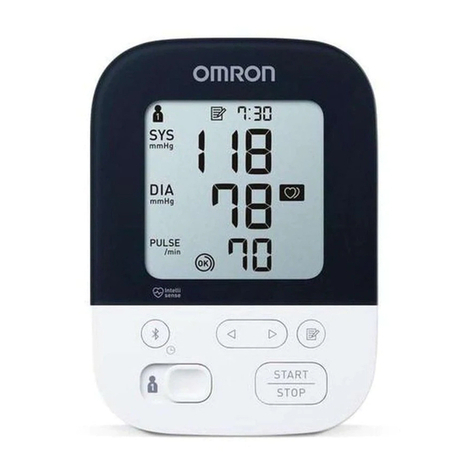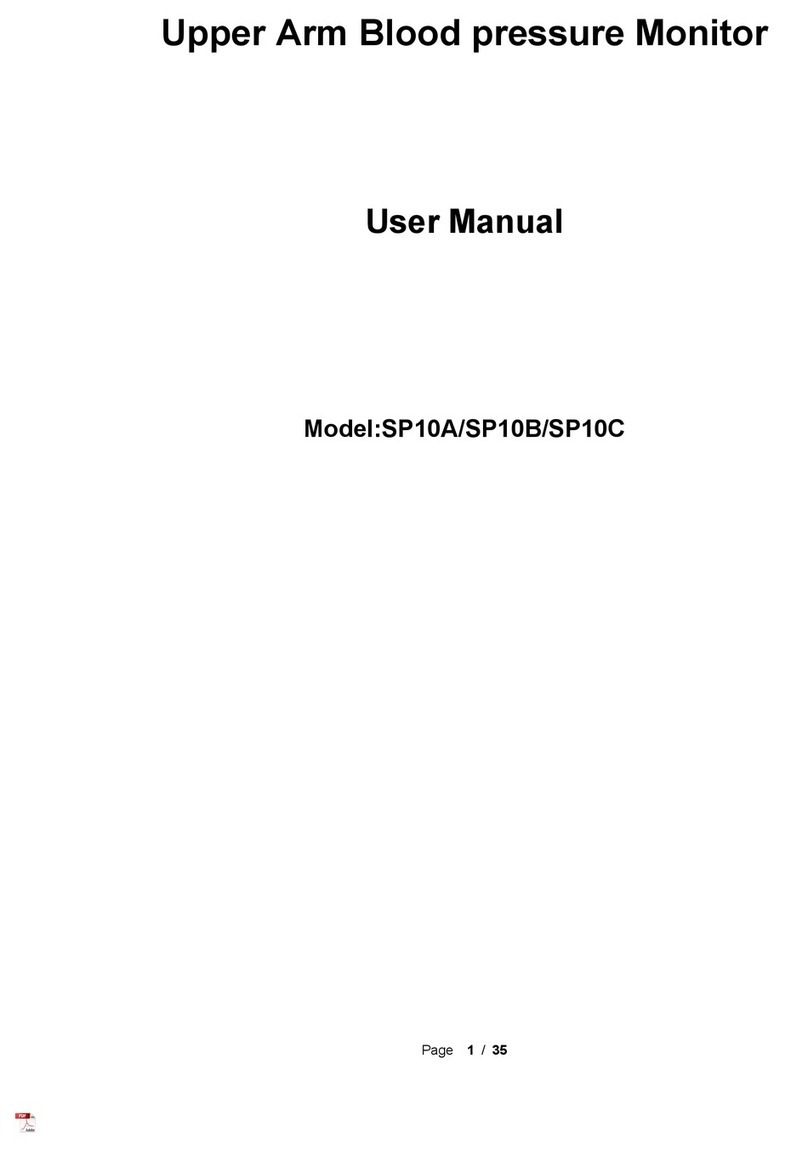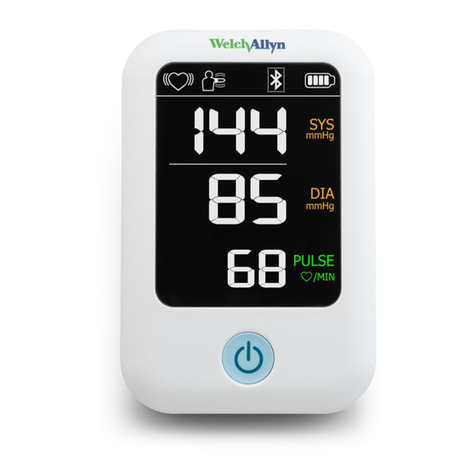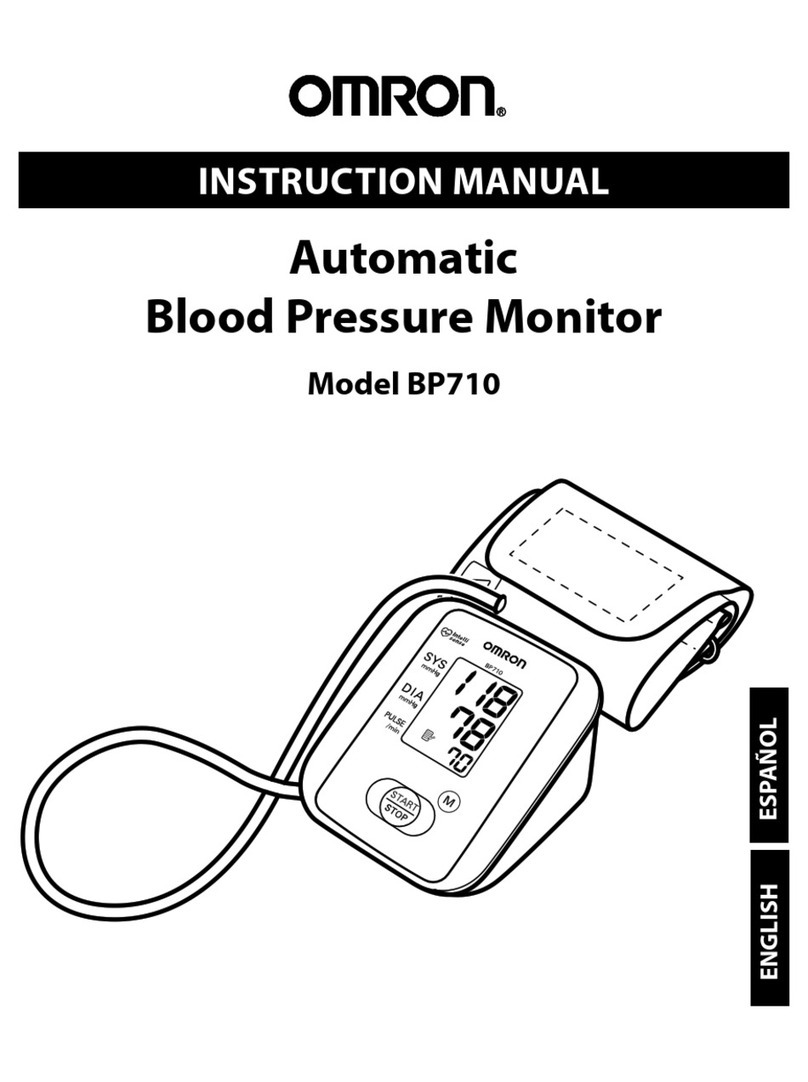AND UA-767 Plus BT User manual

Digital Blood Pressure Monitor
Model UA-767 BT
Instruction Manual
Manuel d
’
instructions
Manual de Instrucciones
Manuale di Istruzioni
Bedienungsanleitung
Gebruiksaanwijzing
使用手册
1WMPD4001441


English 1
Contents
Dear Customers.................................................................... 2
Preliminary Remarks ............................................................. 2
Precautions........................................................................... 2
Parts Identification................................................................ 3
Symbols................................................................................ 4
Using The Monitor ................................................................ 5
Installing / Changing The Batteries .................................. 5
Connecting The Air Hose ................................................. 5
Attaching The Arm Cuff ................................................... 6
How To Take Proper Measurements ................................... 6
Measurement................................................................... 6
After Measurement .......................................................... 6
Measurements ...................................................................... 7
Normal Measurement....................................................... 7
Measurement With The Desired Systolic Pressure ............. 8
Notes For Proper Measurement ........................................ 8
What Is An Irregular Heartbeat .............................................. 9
Pressure Bar Indicator ........................................................... 9
How The Wireless Connection Works..................................... 9
About Blood Pressure.......................................................... 10
What Is Blood Pressure? ................................................. 10
What Is Hypertension And How Is It Controlled? ............. 10
Why Measure Blood Pressure At Home? .......................... 10
WHO Blood Pressure Classification ................................. 10
Blood Pressure Variations............................................... 10
Troubleshooting ................................................................. 11
Maintenance ....................................................................... 12
Technical Data.................................................................... 12

English 2
Dear Customers
Congratulations on purchasing a state-of-the-art A&D blood pressure
monitor, one of the most advanced monitors available today. Designed
for ease of use and accuracy, this monitor will facilitate your daily blood
pressure regimen.
We recommend that you read through this manual carefully before
using the device for the first time.
Preliminary Remarks
This device conforms to the European Directive 93/42 EEC for Medical
Products. This is made evident by the mark of conformity
accompanied by the reference number of the designated authority.
The device complies with the statutory EMC (Electromagnetic
Compatibility) directive 89/336/EEC.
The WML-30AH is approved in accordance to R&TTE directive
transmitter module marked by
0700
, manufactured by MITSUMI
incorporated to OEM product.
The WML-40AH is approved in accordance to R&TTE directive
transmitter module marked by , manufactured by MITSUMI
incorporated to OEM product.
The device complies with part 15 of the FCC rules and contains the FCC
ID POOWML- C30XX and the FCC ID POOWML- C40.
The device is designed for use on adults only, not newborns or infants.
Environment for use
The device is for use indoors.
Precautions
Precision components are used in the construction of this device. Extremes
in temperature, humidity, direct sunlight, shock or dust should be avoided.
Clean the device with a soft, dry cloth. Never use thinner, alcohol,
benzine, or wet cloth.
Avoid tightly folding the cuff or storing the hose tightly twisted for long
periods, as such treatment may shorten the life of the components.
The device and cuff are not water resistant. Prevent rain, sweat and
water from soiling the device and cuff.
Measurements may be distorted if the device is used close to televisions,
microwave ovens, cellular telephones, X-ray or other devices with strong
electrical fields.
Used equipment, parts and batteries are not treated as ordinary
household waste, and must be disposed of according to the applicable
local regulations.

English 3
Parts Identification
Battery Cover
1.5V Batteries
(R6P or AA)
Battery Compartment
Part of Display
Pressure Bar Indicator
MEMORY Systolic Pressure
Diastolic Pressure
Pulse Rate
Battery Indicator
I.H.B. Indicator (Irregular heartbeat indicator) Heart Mark
Display
Air Connector Plug
Air Socket
Arm Cuff
DC Jack
START Button
Air Hose
Index Mark
Proper Fit Range

English 4
Symbols
Symbols Function / Meaning Recommended Action
Standby and power on.
Battery installation guide
Direct current
SN Serial number
Date of manufacture
Type BF: Device, cuff and tubing are
designed to provide special protection
against electrical shocks.
The indicator while measurement is in
progress. It blinks while detecting the
pulse.
Measurement is in
progress. Remain as still
as possible.
Irregular Heartbeat indicator. (I.H.B.)
The indicator that shows when irregular
heartbeats or any excessive body movement
during the measurement are detected.
Previous measurements stored in
MEMORY.
Full Battery
The battery power indicator during the
measurement.
Low Battery
The indicator blinks when battery
power is low.
Replace all batteries with
new ones, when the
indicator blinks.
Unstable blood pressure due to
movement during the measurement.
Try measurement again.
Remain very still during
the measurement.
The systolic and diastolic values are
within 10 mmHg of each other.
The pressure value did not increase
during inflation.
The cuff is not fastened correctly.
PUL. DISPLAY ERROR
The pulse is not detected correctly.
Fasten the cuff correctly,
and try the measurement
again.
SYS Systolic blood pressure in mmHg
DIA Diastolic blood pressure in mmHg.
PUL./min Pulse per minute
EC directive medical device label
0700
R&TTE directive transmitter module label
WEEE label

English 5
Using The Monitor
Installing / Changing The Batteries
1. Slide the battery cover up to open it.
2. Remove the used batteries and insert
new batteries into the battery
compartment as shown, taking care that
the polarities (+) and (-) are correct.
3. Slide the battery cover down to close.
Use only R6P, AA batteries.
CAUTION
Insert the batteries as shown in the battery compartment. If not, the
device will not work.
When
(LOW BATTERY mark)
blinks in the display, replace all batteries
with new ones. Do not mix old and new batteries. It may shorten the
battery life, or cause the device to malfunction.
(LOW BATTERY mark)
does not appear when the batteries are drained.
Battery life varies with the ambient temperature and may be shorter at
low temperatures.
Remove the batteries if the device is not to be used for a long time.
The batteries may leak and cause a malfunction.
Use the specified batteries only. The batteries provided with the device
are for testing monitor performance and may have a limited life.
Connecting The Air Hose
Insert the air connector plug into the air socket firmly.
Step 1
Step 3
Step 2
Air Connector Plug
Air Socket
Air Hose

English 6
Using The Monitor
Attaching The Arm Cuff
1. Wrap the cuff around the upper
arm, about 2 - 3 cm above the
elbow, as shown. Place the cuff
directly against the skin, as
clothing may cause a faint pulse,
and result in a measurement error.
2. Constriction of the upper arm,
caused by rolling up a shirtsleeve,
may prevent accurate readings.
3. Confirm that the index points
within the proper fit range.
How To Take Proper Measurements
For the most accurate blood
pressure measurement:
Sit comfortably at a table.
Rest your arm on the table.
Relax for about five to ten minutes
before measurement.
Place the center of the cuff at the same height as your heart.
Remain still and keep quiet during measurement.
Do not measure right after physical exercise or a bath. Rest for twenty or
thirty minutes before taking the measurement.
Try to measure your blood pressure at the same time every day.
Measurement
During measurement, it is normal for the cuff to feel very tight. (Do not be
alarmed)
After Measurement
After measurement, press the START button to turn off the power.
Remove the cuff and record your data.
Note: The device has an automatic power shut-off function, which turns the
power off approximately one minute after measurement.
Allow at least ten minutes between measurements on the same person.
Rolling up shirtsleeve
2 -3 cm
Const
r
iction of the U
pp
er
A
rm
Air Hose
Cuff
Index and Proper fit range

English 7
Measurements
Model UA-767 BT is designed to detect the pulse and to inflate the
cuff to a systolic pressure level automatically.
If your systolic pressure is expected to exceed 230 mmHg or you use the
optional small cuff, read "Measurement with the desired systolic
pressure" on the next page.
Normal Measurement
1. Place the cuff on the arm (preferably the left arm).
Sit quietly during measurement.
2. Press the START button.
The last data of systolic and diastolic
pressure and pulse rate are displayed
briefly. Then the display changes, as
indicated in the figure at the right, as the
measurement begins. The cuff starts to
inflate. It is normal for the cuff to feel very
tight. A pressure bar indicator is displayed,
as in the figure at the right, during inflation.
Note: If you wish to stop inflation at any time,
press the START button again.
3. When inflation is complete, deflation starts
automatically and the (heart mark)
blinks, indicating that the measurement is
in progress. Once the pulse is detected,
the mark blinks with each pulse beat.
Note: If an appropriate pressure is not
obtained, the device starts to inflate
again automatically.
4. When the measurement is complete, the
systolic and diastolic pressure readings and
pulse rate are displayed. The cuff exhausts
the remaining air and deflates completely.
5. Press the START button again to turn
off the power.
Note: Model UA-767 BT is provided with an automatic power
shut-off function. Allow at least ten minutes between
measurements on the same person.
At heart level
The last data
at initial display
Starts inflation
Pressurizing
Measurement
in progress
Systolic pressure
Diastolic pressure
Pulse rate
Exhausts remaining
air automatically
START button

English 8
Measurements
Measurement With The Desired Systolic Pressure
If your systolic pressure is expected to exceed 230 mmHg or you use the
optional small cuff, use this procedure.
1. Place the cuff on the arm (preferably the left arm).
2. Press and hold the START button
until a number about 30 to 40 mmHg
higher than your expected systolic
pressure appears.
3. Release the START button to start
measurement, when the desired
number is reached. Then continue to
measure your blood pressure as
described on the previous page.
Notes For Proper Measurement
Sit down in a comfortable position. Place the arm to be used for the
measurement on a table or other support so that the center of the cuff
will be at the same height as your heart.
Relax for about five or ten minutes before taking a measurement. If you
are excited or depressed by emotional stress, the measurement will
reflect this stress as a higher (or lower) than normal blood pressure
reading and the pulse reading will usually be faster than normal.
An individual's blood pressure varies constantly, depending on what you
are doing and what you have eaten. What you drink can have a very
strong and rapid effect on your blood pressure.
This device bases its measurements on the heartbeat. If you have a very
weak or irregular heartbeat, the device may have difficulty determining
your blood pressure.
Should the device detect a condition that is abnormal, it will stop the
measurement and display an error symbol. See page 4 for the
description of symbols.
This blood pressure monitor is intended for use by adults only. Consult
with your physician before using this device on a child. A child should not
use this device unattended.
Refer to the previous page
for measurement
Press and hold the button
At heart level
Release the button
at the desired
systolic pressure

English 9
What Is An Irregular Heartbeat
Model UA-767 BT blood pressure monitor provides a blood
pressure and pulse rate measurement even when an irregular heartbeat
occurs. An irregular heartbeat is defined as a heartbeat that varies by
25% from the average of all heartbeats during the blood pressure
measurement. It is important that you be relaxed, remain still and do not
talk during measurements.
Note: We recommend contacting your physician if you see this
indicator frequently.
Pressure Bar Indicator
The indicator monitors the progress of pressure during measurement.
How The Wireless Connection Works
At the end of the measurement, your blood pressure will be sent
automatically to your health monitoring device. You do not need to do
anything. If the health monitoring device is not working or is not within
range of the blood pressure monitor, the blood pressure will be stored in
the blood pressure monitor's memory (up to 40 sets).
Inflation complete
Pressurizing
Inflation in progress Measurement in progress
Releasing air

English 10
Reference Material: Journal of Hypertension 1999, Vol 17 No.2
mmHg
110
105
100
95
90
85
80 Optimal
120 130 140 150 160 170 180
Systolic blood pressure mmHg
Normal
High-normal
Grade 1 hypertension (mild
)
Grade 2 hypertension (moderate)
Grade 3 hypertension (severe)
Diastolic blood pressure
About Blood Pressure
What Is Blood Pressure?
Blood pressure is the force exerted by blood against the walls of the arteries.
Systolic pressure occurs when the heart contracts. Diastolic pressure occurs
when the heart expands. Blood pressure is measured in millimeters of
mercury (mmHg). One's natural blood pressure is represented by the
fundamental pressure, which is measured first thing in the morning while one
is still at rest and before eating.
What Is Hypertension And How Is It Controlled?
Hypertension, an abnormally high arterial blood pressure, if left unattended,
can cause many health problems including stroke and heart attack.
Hypertension can be controlled by altering lifestyle, avoiding stress, and with
medication under a doctor’s supervision.
To prevent hypertension or keep it under control:
Do not smoke Exercise regularly
Reduce salt and fat intake Have regular physical checkups
Maintain proper weight
Why Measure Blood Pressure At Home?
Blood pressure measured at a clinic or doctor's office may cause
apprehension and can produce an elevated reading, 25 to 30 mmHg higher
than that measured at home. Home measurement reduces the effects of
outside influences on blood pressure readings, supplements the doctor's
readings and provides a more accurate, complete blood pressure history.
WHO Blood Pressure Classification
Standards to assess high
blood pressure, without
regard to age, have been
established by the World
Health Organization (WHO),
as shown in the chart below.
Blood Pressure Variations
An individual’s blood pressure
varies greatly on a daily and
seasonal basis. It may vary by
30 to 50 mmHg due to various conditions during the day. In hypertensive
individuals’ variations are even more pronounced. Normally, the blood
pressure rises while at work or play and falls to its lowest levels during sleep.
So, do not be overly concerned by the results of one measurement.
Take measurements at the same time every day using the procedure

English 11
Typical fluctuation within a day
(Measured every five minutes)
PM AM Time
Diastolic blood pressure
Systolic
Diastolic Sleep
described in this manual to get to know your
normal blood pressure. Regular readings give
a more comprehensive blood pressure history.
Be sure to note date and time when recording
your blood pressure. Consult your doctor to
interpret your blood pressure data.
Troubleshooting
Problem Possible Reason Recommended Action
Batteries are drained. Replace all batteries with new ones.Nothing appears
in the display,
even when the
power is turned
on.
Battery terminals are not
in the correct position.
Reinstall the batteries with
negative and positive terminals
matching those indicated on the
battery compartment.
The cuff does
not inflate.
Battery power is low.
(LOW BATTERY
mark)
blinks. [ If the
batteries are drained
completely, the mark
does not appear.]
Replace all batteries with new
ones.
The cuff is not fastened
properly. Fasten the cuff correctly.
You moved your arm or
body during the
measurement.
Make sure you remain very still
and quiet during the
measurement.
The cuff position is not
correct.
Sit comfortably and still.
Raise your hand so that the cuff is
at the same level as your heart.
The unit does
not measure.
Readings are
too high or too
low.
If you have a very weak or
irregular heat beat, the device may
have difficulty in determining your
blood pressure.
The value is different
from that measured at a
clinic or doctor’s office.
See “Why measure blood
pressure at home”.
Other
Remove the batteries. Place them
back properly and try the
measurement again.
Note: If the actions described above do not solve the problem, contact the
dealer. Do not attempt to open or repair this product, as any attempt to do
so will make your warranty invalid.

English 12
Maintenance
Do not open the device. It uses delicate electrical components and an
intricate air unit that could be damaged. If you cannot fix the problem
using the troubleshooting instructions, request service from your dealer
or from the A&D service group. The A&D service group will provide
technical information, spare parts and units to authorized dealers.
The device was designed and manufactured for a long service life.
However it is generally recommended to have the monitor inspected
every 2 years, to ensure proper functioning and accuracy. Please contact
either your authorized dealer or A&D for maintenance.
Technical Data
Type UA-767PBT / UA-767PBT-G
Measurement method Oscillometric measurement
Measurement range Pressure: 20 - 280 mmHg
Pulse: 40 - 200 beats / minute
Measurement accuracy Pressure: ±3 mmHg or 2%, whichever is greater
Pulse: ±5%
Power supply 4 x 1.5V batteries (R6P or AA)
Upper arm circumference 22 - 32 cm (8.7" - 12.6")
Classification Type BF
Clinical test According to ANSI / AAMI SP-10 1987
EMC IEC 60601-1-2: 2001
Wireless communication WML-30AH (MITSUMI Electronics Co. Ltd.)
WML-40AH (MITSUMI Electronics Co. Ltd.)
Operating condition +10°C to +40°C / 30%RH to 85 %RH
Storage condition -10°C to +60°C / 30%RH to 85 %RH
Dimensions Approx. 147 [W] x 64 [H] x 110 [D] mm
Weight Approx. 300 g, excepting batteries
0700
Note: Specifications are subject to change for improvement without prior notice.

Français 1
Sommaires
Chers clients......................................................................... 2
Remarques Préliminaires....................................................... 2
Précautions........................................................................... 2
Nomenclature ....................................................................... 3
Symboles.............................................................................. 4
Utilisation de l’appareil ......................................................... 5
Mise en place / Remplacement des piles .......................... 5
ATTENTION...................................................................... 5
Branchement du tuyau d’air ............................................. 5
Mise en place du brassard................................................ 6
Comment faire des mesures correctes................................ 6
Pendant la mesure ........................................................... 6
Après la mesure............................................................... 6
Les Mesures.......................................................................... 7
Mesure normale............................................................... 7
Mesure avec la pression systolique désirée ...................... 8
Consignes et observations pour une mesure correcte....... 8
Qu’est-ce qu’une frequence cardiaque irrégulière ? .............. 9
Indicateur du progrès de la pression..................................... 9
Fonctionnement de la connexion sans fil .............................. 9
Pression Sanguine............................................................... 10
Qu’est-ce que la pression sanguine?.............................. 10
Qu’est-ce que l’hypertension et comment la contrôler?.. 10
Comment mesurer la pression sanguine chez soi?.......... 10
Classification de la pression sanguine suivant l’OMS ...... 10
Variations de la pression sanguine................................. 10
Recherche des Pannes......................................................... 11
Entretien............................................................................. 12
Données Techniques........................................................... 12

Français 2
Chers clients
Félicitations pour l’achat de ce moniteur de la pression sanguine A&D dernier
cri, un des moniteurs les plus avancés disponibles aujourd’hui. Etant étudié
pour facilites d’utilisation et la précision, ce moniteur vous aidera au quotidien
dans la mesure de la pression sanguine.
Lisez ce manuel en entier soigneusement avant d’utiliser l’appareil pour
la première fois.
Remarques Préliminaires
Cet appareil est conforme à la directive européenne 93/42 EEC des appareils
médicaux. Le marquage de conformité accompagné du numéro de
référence de l’autorité désignée atteste de cette conformité.
Cet appareil est conforme à la directive statutaire sur la compatibilité
électromagnétique (EMC) 89/336/EEC.
Le WML-30AH est approuvé conformément au module émetteur de la
directive R&TTE comportant le marquage
0700
,fabriqué par MITSUMI et
intégré au matériel informatique d’origine.
Le WML-40AH est approuvé conformément au module émetteur de la
directive R&TTE comportant le marquage ,fabriqué par MITSUMI et
intégré au matériel informatique d’origine.
Cet appareil est conforme à la section 15 des règlementations de la FCC et
comporte le code POOWML-C30XX de la FCC et le code POOWML-C40 de la
FCC.
Cet appareil est conçu pour tous excepté les nouveaux nés et les enfants.
Lieu d’utilisation
Cet appareil est destiné à une utilisation domestique.
Précautions
Cet appareil est équipé de pièces de précision. C’est pourquoi il faut éviter de
l’exposer à de fortes températures, une humidité extrême et au soleil. De
même il faut éviter les chocs et le proteger de la poussière.
Nettoyez cet appareil avec un chiffon doux et sec. N’utilisez jamais de diluant,
d’alcool, de benzène ou de chiffons mouillés.
Evitez de tordre le manchon ou de laisser le tuyau trop plié pendant de
longues périodes ce qui pourraient avoir une influence néfaste sur la durée de
vie des pièces.
L’appareil et le manchon ne sont pas imperméables. Evitez de les mouiller
avec de l’eau, de la transpiration ou la pluie.
Les mesures peuvent être faussées si l’appareil est utilisé près d’un poste de
télévision, un four à micro ondes, un téléphone cellulaire, des appareils à
rayon X ou tout autre appareil dégageant de forts champs électriques.
L’appareil usé, les pièces et les piles ne doivent pas être jetées comme les
déchets ménagers ordinaires, elles doivent être traitées conformément à la
législation en vigueur.

Français 3
Nomenclature
Jack en courant continu
Affichage
Connecteur
de prise d’air
Douille d’air
Brassard
Bouton START
(mise en marche)
Tuyau d’air
Couvercle
logement des piles
Piles 1,5 V
(R6P ou AA)
Logement des piles
Partie d’Affichage
Indicateur du progrès de la
pression
Pression systolique
Pression diastolique
Indicateur des piles
Indicateur des pulsations cardiaques irrégulières Marque de cœur
Plage d’accord
appropriée
Marque d’inde
x
MEMOIRE
Pouls

Français 4
Symboles
Symboles Fonction / Signification Traitement
Pour allumer ou mettre en veille l’appareil
Répères pour installer les piles
Courant continu
SN Numéro de série
Date de fabrication
Type BF: L’appareil, le brassard et les tubes
isolants ont été conçus de manière à fournir
une protection particulière contre les
électrochocs.
Apparaît lorsque la mesure est en cours et
clignote quand les pulsations cardiaques sont
détectées.
L’appareil est en train de
mesurer; restez calme.
Cet indicateur détecte les pulsations
cardiaques irregulières ou autres mouvements
de corps excessifs pendant la mesure.
Les mesures précédentes conservées dans la
MEMOIRE.
Full Battery
L’indicateur de la tension des piles pendant la
mesure.
Low Battery
La tension des piles est faible quand il
clignote.
Remplacer toutes les piles par
des neuves quand cet
indicateur clignote.
Apparaît en cas de fluctuation de la pression
due à un mouvement pendant la mesure.
Recommencez la mesure.
Restez parfaitement tranquille
pendant la mesure.
Apparaît si la difference entre la pression
systolique(tension maxima) et la pression
diastolique(tension minima) est inférieure à 10
mmHg.
Apparaît lorsque la pression n’augmente pas
pendant le gonfage du brassard.
Apparaît lorsque le brassard n’est pas attaché
correctement.
PUL. DISPLAY ERROR
La pression n’est pas détectée correctement.
Attachez le brassard
correctement, et
recommencez la mesure.
SYS Pression systolique en mmHg.
DIA Pression diastolique en mmHg.
PUL./min Pouls: nombre de pulsations cardiaques par minute.
Label des appareils médicaux conformes à la
directive européenne.
0700
label du module émetteur de la directive R&TTE
Marquage WEEE

Français 5
Utilisation de l’appareil
Mise en place / Remplacement des piles
1. Faites glisser le couvercle du logement des piles
pour l’ouvrir.
2. Enlevez des piles usées et insérez des piles
neuves dans le logement en respectant bien les
polarités (+) et (-) indiquées.
3. Faites glisser le couvercle en bas pour le fermer.
Utilisez uniquement des piles R6P, LR6 ou AA.
ATTENTION
Veillez à insérer les piles dans le bon sens, sinon
l’appareil ne fonctionnera pas.
Lorsque la marque (pile faible) apparaît sur l’écran, changez toutes les piles par
des neuves. Ne mélangez pas les piles neuves et anciennes car cela pourrait
raccourcir leur durée de vie ou détériorer l’appareil.
La marque (pile faible) n’apparaît pas lorsque les piles sont épuisées.
La durée de vie des piles varie avec la température ambiante et peut être raccourcie
par des températures basses.
Utilisez uniquement les piles spécifiées. Les piles fournies avec l’appareil sont pour
tester les performances de l’écran d’affichage et peuvent donc avoir une courte durée
de vie.
Retirez les piles lorsque l’appareil n’est pas utilisé pendant un long moment. Les piles
pourraient fuir ce qui entraînerait un mauvais fonctionnement de l’appareil.
Les données conservées s’effacent quand les piles sont enlevées.
Branchement du tuyau d’air
Insérez fermement le raccord d’air mâle dans le raccord d’air femelle.
Procédure 1
Procédure 3
Procédure 2
Air Socket
Raccord d’air mâle
Tuyau d’air

Français 6
Utilisation de l’appareil
Mise en place du brassard
1. Enroulez le brassard autour du bras, à 2 ou
3 cm au-dessus du coude, comme indiqué
sur l’illustration ci-contre. Placez le brassard
directement sur la peau, car un vêtement
pourrait assourdir la pulsation et provoquer
une erreur de mesure.
2. Evitez également de remonter la manche,
car elle comprimerait le bras ce qui pourrait
aussi provoquer une erreur de mesure.
3. Confirmez que l’index se trouve à
l’intérieur de la plage d’accord appropriée.
Comment faire des mesures
correctes
Pour une meilleure précision des mesures
de la pression sanguine :
S’asseoir confortablement à une table.
Poser son bras sur la table.
Se relaxer pendant 5 à 10 minutes avant
de commencer les mesures.
Lever le bras de sorte que le centre du brassard soit à la même hauteur que le coeur.
Bouger le moins possible et rester calme pendant les mesures.
Ne pas faire de mesure juste après un effort physique ou un bain. Se reposer pendant
20 à 30 minutes avant de faire les mesures.
S’efforcer de mesurer la tension à la même heure tous les jours.
Pendant la mesure
Pendant la mesure, il est normal que l’on sente que le manchon est très serré. (Ne
pas s’inquiéter.)
Après la mesure
Après la mesure, appuyez sur le bouton START pour éteindre l’appareil.
Enlevez le brassard et notez votre tension et votre pouls.
Note: Cet appareil est doté de la fonction de mise hors tension automatique, qui éteint un
appareil automatiquement dans un délai d’une minute après la mesure.
Attendez au moins une dizaine de minutes avant de remesurer votre tension (ou
celle d’une autre personne) à des fins de confirmation.
Retroussement de la manche
2 -3 cm
Constriction du bras supérieur
Tuyau d’ai
r
Brassard
Index et la plage d’accord approriée
Other manuals for UA-767 Plus BT
1
Table of contents
Languages:
Other AND Blood Pressure Monitor manuals

